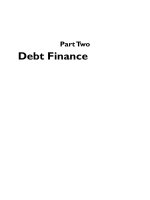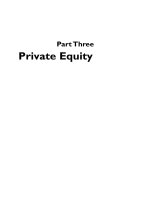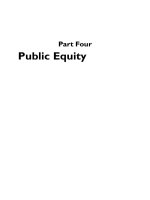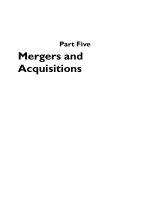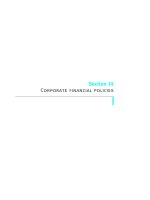Minicase Chapter 13 Corporate Finance
Bạn đang xem bản rút gọn của tài liệu. Xem và tải ngay bản đầy đủ của tài liệu tại đây (654.95 KB, 9 trang )
1. The book value of the company’s equity is the same as stockholder’s
equity, which can be computed by subtracting the total value of liabilities
from total assets.
(Total Assets) = (Total) Liabilities + Stockholder’s Equity (book value of
equity).
Stockholder’s Equity (book value equity) = Total Assets – Total Liabilities.
The book value of the company’s liabilities and equity was found from
the site . I found Dell’s Form 10K, dated April 17,
2020, and snap short is attached here with. Dell’s Form 10K shows the
following:
Book value of equity: 10-K:
Total Assets = 118.861 millions; Total Liabilities = 115.077
Book value of equity = Total Assets – Total Liabilities
= $118.861 - $115.077
= $3.784 millions
The book value of the company’s liabilities and equity was found from
the site . I found Dell’s Form 10q, dated April 17,
2020, and snap shot is attached here with. Dell’s Form 10q showed the
following
Book value of equity: 10-Q:
Total Assets = 116.814 millions; Total Liabilities = 112.003 millions
Book value of equity = Total Assets – Total Liabilities
= $116.814 - $112.003
= 4.811 millions.
Book Value of Debt: 10K = $118.861 millions
10Q = $116.814 millions
Long-term Debt:
10K = $44.319 millions
10Q = $44.727 millions
2.
I collected information on April 6 2020 to calculate the CAPM.
th
Most recent stock price of Dell: $36.44
Market capitalization: 26.95B
Shares outstanding: 254.4M
Beta of Dell: 0.8766
Yield on 3-month Treasury Bills: 0.091%
With 7% market risk premium, using CAPM to calculate cost of equity:
R = R + β × (R – R )
S
F
M
F
= 0.091% + 0.8766 × 7%
= 0.0623 = 6.23%
Cost of equity for Dell= 6.23%
3.
Company
Beta
Dell
0,8
IBM
1,27
HPQ
1,34
XRX
2,08
Lenovo
1,25
AAPL
1,17
ASUS
0,61
CSCO
0,99
Acer
1,04
Average beta = 1,172
Cost of equity using the average beta:
Rs = 0,091% + 1,172 x 7%
= 8,295%
* It would not matter whether we use beta for Dell or beta for industry,
because if you believe that the operations of Dell is similar to the
operations of the rest of the industry, you should use the industry beta to
reduce estimation error. But if you believe that the operations of Dell is
fundamentally different from those in the rest of the industry, the Dell’s
beta should be used.
4.
Book Perc Quote Marke Perc
value
ent
d
t
ent
(millio
of
value value
of
ns)
total (millio (millio total
©
ns)
ns)
(a)
DEL
L
GB
300
0.17
126.58 275.01
0
6
0.17
Yield Weigh Weigh
to
ted
ted
Matu book marke
rity values
t
(b)
(c*b) values
(a*b)
4.723 0.80%
%
0.80%
DEL
L GF
600
0.33
104.23 566.20
5
2
0.35
0.842 0.28%
%
0.30%
DEL
L
GG
500
0.28
118.34 460.53
5
0
0.28
2.401 0.67%
%
0.67%
DEL
L
GH
400
0.22
125.00 322.90
5
0
0.20
4.583 1.01%
%
0.92%
TOT
AL
1800
1.00
1624.6
5
1.00
2.76%
2.69%
Analyzing above table, it seems that weighted average cost of debt
using book value, the weights are 2.76 percent, and using market
value,the weight are 2.69 percent. It seems irrelevant whether we use
book or market values to calculate the cost of debt for Dell,which means
it would not make a diffence whether the book or market values were
used because they are the approximately the same, and yields almost
the same cos of debt.
5.
Using book value weights, the total value of Dell using 10K annual
values is:
V= 1.800.000.000 + 3.784.000.000
V= 5.584.000.000
So, the WACC based on book value weights using 10K annual value is:
WACC= (E/V)*Rs + (D/V)*Rb*(1-T)
Where:
Rs= cost of equity
Rb= cost of debt
E= market value of the firm’s equity
D= market value of the firm’s debt
V= D+E
E/V= percentage of financing that is equity
D/V= percentage of financing that is debt
T= corporate tax rate
WACC= (3.784.000.000/5.584.000.000)*0,0623 +
(1.800.000.000/5.584.000.000)*0,0276*(1-0,35)
= 0,048
=4,8%
Now using the market value weights, the total value of Dell is:
V= 1.624.650.000 + 26.950.000.000
V= 28.574.650.000
WACC based on market value weights is:
WACC= (E/V)*Rs + (D/V)*Rb*(1-T)
WACC= (26.950.000.000/28.574.650.000)* 0,0623 +
(1.624.650.000/28.574.650.000)*0,0269*(1-0,35)
= 0,0598
= 5,98%
Conclusion: the cost of capital for Dell using market value weights is
higher than book value weights because of higher market-to-book ratio
for Dell. The market value is more relevant because it is the actual sale
value of the company.
6. Using Dell as a representative company to estimate cost of capital,
the potential problem with CGI is that it operates stores for company’s
sales, while Dell sales through ít internet site. This could be one of the
risk factor affecting the cost of capital. Another factor affecting the cost of
capital is that Dell is a fortune 500 company and is ine of the leaders in
its industry, so it can access capital being a pubic company, while CGI is
privately owned company.
The improvement which I might suggest that CGI should go as a public
sector company and sale its products on internet like Dell.

